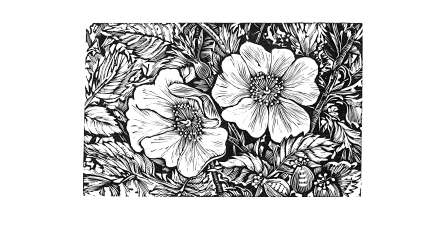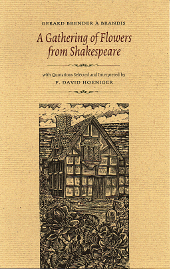The Porcupine's Quill
Celebrating forty years on the Main Street
of Erin Village, Wellington County
BOOKS IN PRINT
A Gathering of Flowers from Shakespeare by Gerard Brender à Brandis and David Hoeniger
‘Gerard Brender à Brandis is a renowned wood engraver, whose works of densely textured intricacy vibrate across your vision, drawing you into a microscopically magic world.’

In this remarkable volume, one of Canada’s most celebrated artists has collaborated with a distinguished professor of English to create a work of art and scholarship both beautiful and informative.
Sir Phillip Sydney, one of the earliest of English literary critics, claimed that the purpose of ‘poesie’, or literature, was ‘to teach and to delight’. A Gathering of Flowers accomplishes both goals with great success. The artist’s astonishingly realistic images are accompanied by a succinct education in the nature and properties of flowers, and by the quotations and explication of lines written by the greatest poet of the English language. Shakespeare used flower imagery in many of his plays, providing dramatic significance as well as aeshetic effect. David Hoeniger cites many of these, including Oberon’s vivid ...
‘I know a bank whereon the wild thyme blows,
Where oxlip and the noffdding violet grows,
Quite over-canopied with luscious woodbine,
With sweet musk-roses and with eglantine.
There sleeps Titania sometime of the night,
Lull’d in these flowers with dances and delight.’
For each quotation, he provides an explanation of the significance or symbolism of the floral image. The beauty of Shakespeare’s poetry is complemented by the vivid artistry of the engravings. This co-operative effort of artist and scholar has been most successful in fulfilling Sir Phillip’s stated purpose, to teach and to delight.
Review quote
‘Brender à Brandis’ delicate illustrations evoke tremendous texture for a medium as difficult as wood engraving, and have a wild, almost Art Nouveau quality.’
—Globe and Mail
Review quote
‘The passage of four centuries certainly adds to the challenge of identifying species from common names. What flowers did Shakespeare have in mind when he spoke of love-in-idleness, eglantine, herb of grace or long purples? By answering many such intriguing questions, this book enhances the reader’s understanding of, and appreciation for Shakespeare’s works.’
—Marilynn Murphy, Toronto Field Naturalist
Review quote
‘This dandy little book is a selection of Shakespeare’s flower and plant imagery, accompanied by the Brandis engravings -- which were originally produced from endgrain wooden blocks and hand-printed on an 1882 Albion press for a limited edition of 97 copies in 1997. The text, which presents brief ‘‘quotations’’ from Shakespeare selected and explained both symbolically and botanically by Hoeniger, is not just a vehicle for the artwork but is pleasantly informative. You’ll find out, for instance, what Hamlet’s Gertrude had in mind when she alluded to the ‘‘grosser names’’ for the roots of the purple orchid: priest’s pintle (you got it right the first time), dogstones and goat’s cullions (cujones). You don’t have to be biased, like me, to see at a glance that A Gathering of Flowers from Shakespeare is a perfect little gem, ideal for lovers of wood engravings, flowers, printmaking or even just Shakespeare.’
—Hans Werner, Toronto Star
Review quote
‘I have for years daydreamed about planting and tending a Shakespeare garden: a garden that would boast every flowering plant mentioned in Shakespeare’s poems and plays. I assure you, this is not a solitary, invented obsession. Hundreds of public and countless private Shakespeare gardens exist around the world, one of the most famous at the Huntington Library in California, and these extraordinary gardens offer the twin pleasures of Shakespeare’s art and Nature’s beauty.
‘Gerard Brender à Brandis, and F. David Hoeniger’s A Gathering of Flowers from Shakespeare is a truly beautiful companion to my daydreams. And if you also love beautifully constructed books and the stark power of wood engravings, you will find yourself flipping through this well-conceived and artfully constructed book again and again.’
—Shannon Murray, edwardsmagazine
Review quote
‘Brender à Brandis’ skillful descriptions of the structures of various species of plants and flowers invite close study. Each print is loaded with intricate visual information and captivates the viewer with a rich interplay of negative and positive space. There are often structures in the prints which, when followed, recall Celtic knots which move in, out and around.’
—Jim Westergard, Amphora
Review quote
‘A Gathering’s juxtaposition of name, image, history and poetic resonance work to (re)introduce a materiality into botanical language that may be missing for the urban reader. As we read, one by one, gradually a broader effect accumulates: a sense of the vibrant link between the floral world and language’s turn to it for expression of abstract emotional experience, and a sense of the currency, accessibility and popular consciousness of that link within Elizabethan era expression.
‘I was not expecting such an experience: I had anticipated a largely cerebral and the (merely) specular pleasure of a pretty display of flowers counterpointed with pretty poetic accompaniments. But reading the book in one sitting (easily done within an hour or two) surprised me by accessing my love of language through syllables that I had not thought could ever move me. Names like columbine, cowslip and flax had generally produced in me only stirring apprehensions of ‘‘flower’’ or ‘‘seed’’; now these words are for me reinvested with not only their early symbolisms but with a situation in language I still find affecting and with shape. Though at first I found the black ink of each woodcut limiting, I gradually came to appreciate the focus on shape that the limit forced, as it trained my eye to the shape of each petal and leaf, rather than to the easy distinguishment through colours, in order to know a word as a particular flower.’
—Sonnet L’Abbe, The Goose
Review quote
‘Gerard ... sees himself in the longer tradition of medieval scribes and Gutenberg, and most of his important connections are with artists and craftsmen of Europe and the past. His engraving is very much in the British tradition, with the feel of such engravers as Mackley, Robert Gibbings, Joan Hassall and Monica Poole.... In Gerard’s case, being a book artist includes being able to do all aspects of the production himself. No other Canadian private press printer is able to combine typesetting and printing with wood engraving, papermaking, spinning, weaving and bookbinding. His lifestyle, which is spare and simple, imposes the onus of inventing and doing everything self sufficiently and provides the opportunity to explore his creativity as fully as possible.’
—Kim Lewis, Multiples, the Journal of the Society of Wood Engravers
Introduction or preface
Though not a botanist, Shakespeare as a poet and dramatist wrote many memorable lines about flowering plants. These have inspired artists over the ages, to whose works we hope the engravings in this book will be a worthy addition.
Shakespeare, like Chaucer before him, and Keats and Shelley and Whitman long after, had a special fondness for flowers. The unusually keen and wide observation of life that marks the characterization and human drama in his plays also informs some of his more vivid descriptions of plants and their habitat, as several passages in this book show. Yet this does not mean that Shakespeare studied plants like the keen naturalist or gardener who is interested in the clear distinction of related species. Often he was content with a mere family name, like violet or lily or pink, and therefore, unless the context provides some other clue, the engravings accompanying such passages show what we think was the most familiar species of the family in England in Shakespeare’s time, either in gardens or in the wild.
Of the three kinds of gardens at the time, medicinal herb, fruit and vegetable, and ornamental, the two latter especially were being constantly enriched by interbreeding ... and by importation from other parts of the world. But as a man from a small country town, Shakespeare also knew the common flowers of fields, wastelands, woods, heaths, and marshland.... Many members of his audiences in London too -- a city then of only 200,000 -- were more familiar with both domesticated and wild flora than urban people tend to be today. They would have been able to visualize plants like saffron, poppy, and aconitum from the mere mention of the narcotics or poisons made from them. For that reason, and because of their attractiveness for engravings, we have included them. On the other hand, we omitted some familiar crop plants with insignificant flowers, and we drew the line between flowering shrubs and trees, omitting the latter.
Not surprisingly, there are a few flowers like violet and daisy to which Shakespeare refers dozens of times; in those cases we merely cite attractive representative examples. At the same time, several of Shakespeare’s best-known passages refer to groups or clusters of flowers; sometimes in a brief poetic description like Oberon’s in A Midsummer Night’s Dream; sometimes in a song like that near the end of Love’s Labour’s Lost or the one at the beginning of The Two Noble Kinsmen; and sometimes as the subject of a dialogue with action, at the centre of which is a ‘flower-maiden’, as in the case of Ophelia in her mad scene in Hamlet, Marina in Pericles, and Perdita in her long dialogue with Polixenes in The Winter’s Tale. The accompanying engravings show groups of flowers, some of which are presented and discussed individually elsewhere. Usually the flowers are mentioned in a human context, as one would expect in drama in such ritual as a marriage song. In Shakespeare’s time much more than today, many flowers, for instance violets, rosemary, and rue, had symbolic associations, as is clear, for example, in the Ophelia episode. The commentary in this book examines such meanings. It also explicates what plant Shakespeare actually meant when he used a certain name; for instance, honeysuckle is synonymous with woodbine.
Our own study of the subject has greatly benefited from that of the Reverend Henry N. Ellacombe, The Plant-Lore and Garden-Craft of Shakespeare (second edition, 1884), a work that is remarkably comprehensive and reliable. Commentaries in some modern scholarly editions of Shakespeare, especially those in the Arden series, proved helpful with identification and meanings. For current botanical names and precise descriptions we have turned to such guides as Flora of the British Isles by A. R. Clapham, T. G. Tutin, and E. F. Warburg (1952), and the Collins Pocket Guide to Wildflowers by David McClintock and R. S. R. Fitter (fifth impression, 1965). Most line references to Shakespeare passages cited are to the Riverside Shakespeare (textual editor, G. B. Evans, 1974), but spelling follows Oxford standard and some textual readings reflect our own critical preference.
—F. David Hoeniger
A member of the Wood Engravers’ Network, Gerard Brender à Brandis has produced hundreds of drawings, wood engravings and watercolours of plants, landscape, buildings and musical instruments. These images have appeared in books, including Wood, Ink and Paper, At Water’s Edge and Portraits of Flowers (all published by The Porcupine’s Quill) as well as in his own handmade editions. His work is represented in the collections of the Royal Botanical Gardens (Hamilton, Ontario), the Missouri Botanic Garden, the Arnold Arboretum and the Hunt Botanical Library. His garden and his studio are located in Stratford, Ontario.
For more information please visit the Author’s website »
F. David Hoeniger is professor emeritus from Victoria College, University of Toronto, where he taught for many years in the Department of English. He is also a former director of the university’s Centre for Reformation and Renaissance Studies. Professor Hoeniger is the author and editor of numerous works on Shakespeare, his work and his times, including Medicine and Shakespeare in the English Renaissance (1992), and Science and the Arts in the Renaissance (edited with John W. Shirley, 1985). His editions of Shakespeare include the Arden Pericles (1963) and the Penguin version of King Henry the Eighth (1966). Professor Hoeniger lives in Toronto.
The Porcupine's Quill would like to acknowledge the support of the Ontario Arts Council and the Canada Council for the Arts for our publishing program. The financial support of the Government of Canada through the Canada Book Fund (CBF) is also gratefully acknowledged.






